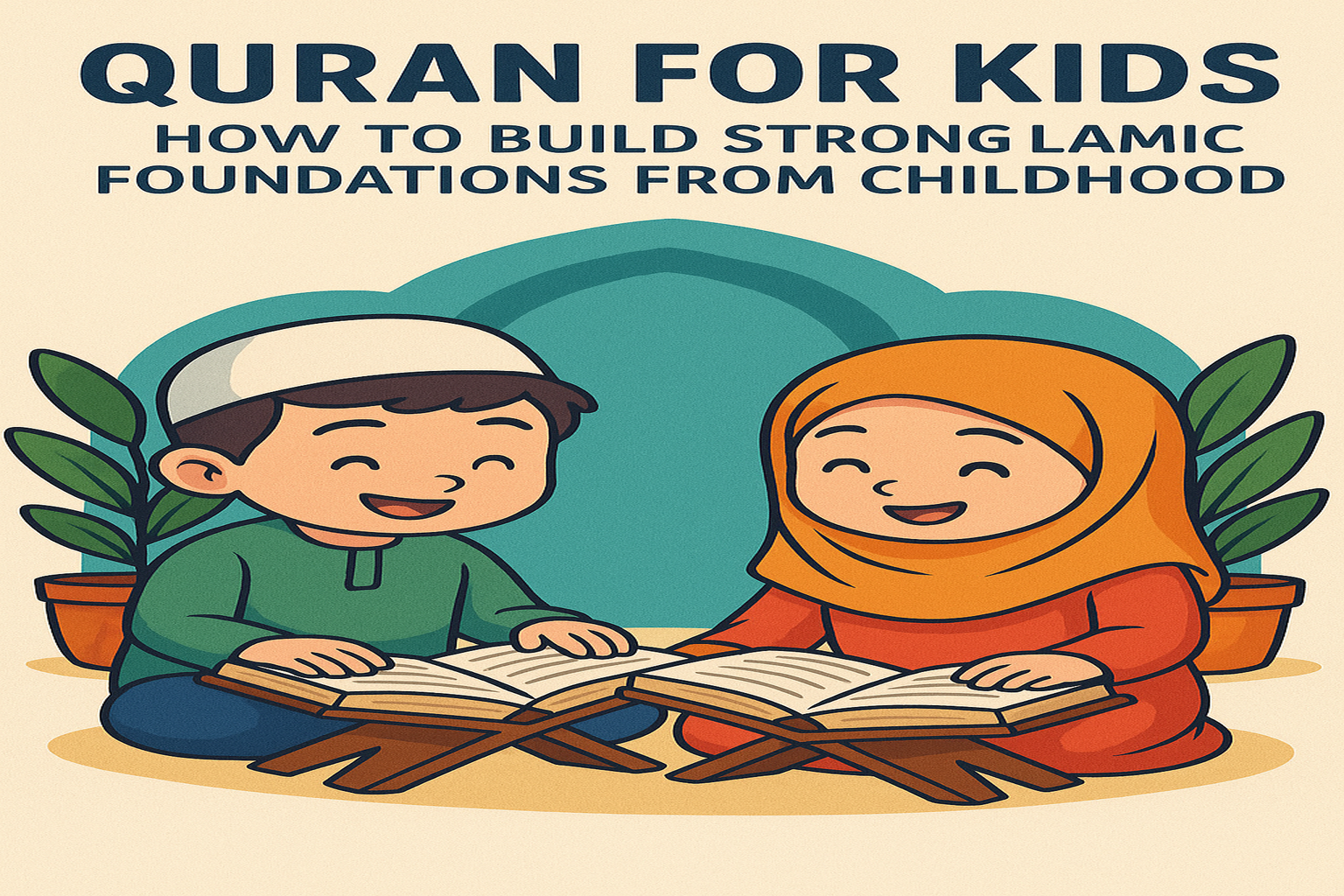
7 Powerful Ways Quran for Kids Builds a Lifelong Islamic Foundation
Raising children with strong Islamic values means more than teaching prayer or manners—it means planting the roots of faith early. Quran for kids offers that deep-rooted foundation. In this blog, discover 7 practical and impactful steps—with emotion, numbers, and power—to bring the Quran alive for your kids.
Discovering Quran for Kids – Why It Matters
When you search for Quran for kids, you’re looking for more than recitation: you want meaning, connection, and growth. Introducing the Quran early shapes a child’s worldview cultivates humility, and injects unmatched love for Allah and Prophet Muhammad ﷺ.
-
Love over rules: Kids remember what they love. The Quran teaches them to love first.
-
Value formation: Core values—honesty, kindness, gratitude—are woven into every verse.
-
Psychological stability: Connecting with Allah decreases anxiety and builds security.
-
Identity and belonging: Proud Muslim kids identify with their faith from day one.
1. Use Engaging Visuals & Colorful Storytelling
Kids are visual learners. Make Quran for kids by:
-
Illustrated storybooks: Choose kid-friendly books that retell Quranic stories with strong visuals.
-
Colorful Tajweed charts: Basic pronunciation guides using bright diagrams.
-
Animated digital tools: Apps that teach the Qur’an through bite-sized, interactive media.
Why it works: Children engage through their senses. Visual storytelling makes Quran for kids relatable and memorable, boosting retention and enthusiasm.
2. Structured, Age-Appropriate Learning
Learning pace matters. Tailor Quran for kids materials to age groups:
-
Ages 3–5: Simple dua’s, short surahs like Iqra’ and Mu’awwidhatayn.
-
Ages 6–9: Short surahs (e.g., Al-Fatiha to An-Naba), basic tafsir stories.
-
Ages 10–12: Longer passages, memorization, and thematic lessons (e.g. salah, respect).
How to implement:
| Age Range | Content Focus | Strategy |
|---|---|---|
| 3–5 | Iqra’, Dhahaba, basic duas | Short daily recitation; playful repetition |
| 6–9 | Juz’ Amma, Prophet stories | Group tafsir; daily themed “ayah hunts” |
| 10–12 | Juz’ Tabarak, week-long “Quran journaling” | Daily journaling; discussion & reflection |
This approach ensures Quran for kids is developmentally sound—challenging and fun at the same time.

3. Build Emotional & Spiritual Connections
Kids should feel the Quran in their hearts. Don’t just recite—feel it.
Turn Moments into Lessons
-
Bedtime reflection: After reciting Mu’awwidhatayn, ask, “If you ever feel scared, whom do you ask for help?”
-
Nature walk: Recite Ayat al-Kursi and marvel at Allah’s creation.
-
Family dua time: Let kids lead a dua and share heartfelt words.
Connect Stories to Life
-
From the story of Prophet Yunus, ask, “What do we do when we feel alone?” This turns verses into moral compasses.
-
Let kids draw or act out prophets’ journeys—making Quran for kids vividly emotional and deeply rooted.
4. Gamify Learning with Rewards & Challenges
A little competition—and reward—can turbocharge progress.
-
Quran memorization charts: Stickers for each aya memorized.
-
Weekly Quran game night: Quiz about surahs, meanings, and characters.
-
Family “Quran Olympics”: Mini-ceremonies and prizes for consistent reciters.
This structured motivation supports momentum and reinforces the value of consistency in Quran for kids.
5. Incorporate Technology the Right Way
Digital isn’t the enemy—it can be your ally.
-
Interactive apps like Learn Quran Kids or Noorani Qaida.
-
Kid-friendly YouTube reciters with clear tajweed.
-
Voice-recording tools: Kids record and listen back to their recitation.
Tech tip: Limit session length—15–20 minutes tops. Use parental filters and supervise content. This ensures Quran for kids is safe, structured, and effective.
6. Encourage Memorization Through Understanding (Tafsir)
Memorization is stronger when kids grasp meaning.
-
Pair each short surah with a simplified tafsir.
-
Use simple metaphors: comparing Al-Fatiha to a conversation with Allah.
-
Encourage “Quran Journaling”: kids write a line and draw what it means to them.
For example, “Alhamdulillah” means “All praise is due to Allah.” Ask: “What are three things you’re thankful for today?” This cements the meaning behind the words.
7. Cultivate a Quran-Centered Home Environment
Children mirror their environment—make home a Quran hub.
-
Decorate with framed Arabic calligraphy.
-
Use kitchen magnets with short ayat.
-
Dedicate a “Quran corner” with plush mats and simple holders.
Model consistent recitation. When kids see parents reciting even briefly, Quran for kids becomes a family rhythm, not just a lesson.
Bonus Tips: Deepen the Impact of Quran for Kids
Use Peer Support & Community
-
Join weekly Quran playdates or classes.
-
Encourage siblings to recite together.
-
Invite community reciters for storytelling nights.
Celebrate Achievements
-
Make a ceremony when a child completes a surah.
-
Give meaningful gifts: special Quran bookmarks, and prayer mats.
-
Record progress—both audio and visual—and revisit old recordings after months.
Keep It Regular, Not Rigid
-
Schedule 10–15 minutes daily, consistently.
-
Theme recitations around events—Ramadan, Lailat al-Qadr, Eid.
-
Allow breaks when kids are sick, tired, or overwhelmed.
8 Rewards: Real Benefits of Quran for Kids
-
Stronger spiritual identity
-
Improved concentration and memory
-
Emotional resilience
-
Enhanced language skills
-
Moral compass formation
-
Sense of purpose and belonging
-
Peace and comfort in daily life
-
Lifelong connection to Allah
These aren’t hypothetical—they’re real, measurable, and often life-changing in childhood development.
Overcoming Challenges – Common Questions Answered
What if my child resists?
-
Shift to playful formats—songs, crafts, puppets.
-
Give choices: “Do you want to recite with me or your brother?”
-
Start shorter: baby steps, big results.
What about pronunciation mistakes?
-
Encourage and correct gently.
-
Use apps with Tajweed visualizations and slow audio.
-
Schedule short tajweed-focused drills once a week.
I don’t speak Arabic fluently—can I still teach?
-
Absolutely. Use translations and transliterations alongside recitation.
-
Learn with your child—growth together builds bonds and confidence.
Craft Your Quran for Kids Plan in 5 Steps
-
Set Goals
-
“Memorize Surah Al-Ikhlas in 2 weeks”
-
“Understand Ayatul Kursi’s meaning”
-
-
Choose Methods
-
Visual storybooks, digital apps, journaling
-
-
Schedule Sessions
-
10 minutes after Fajr, bedtime recitation
-
-
Track Progress
-
Charts, milestone certificates, recordings
-
-
Celebrate Milestones
-
Small rewards, community acknowledgment, family iftars
-
Final Takeaway: Quran for Kids Is a Gift That Lasts a Lifetime
Investing in Quran for kids doesn’t just raise reciters—it raises character. It builds emotional intelligence, ethical clarity, inner calm, and a sense of identity. It plants seeds that will grow into a lifelong partnership with Allah.
Closing Thoughts
Quran for kids is a powerful tool when delivered with creativity, structure, and emotion. Use visuals, stories, tech, community, and celebration to make it resonate. With consistent love and intention, your child’s connection to the Quran can become a personal treasure—not just a religious duty.




